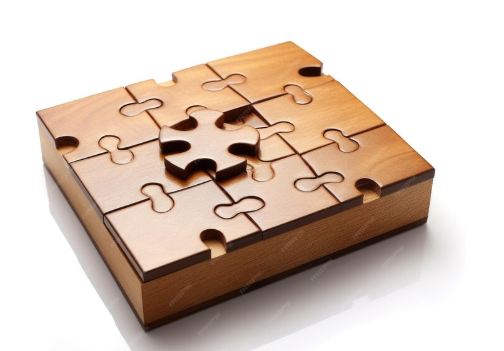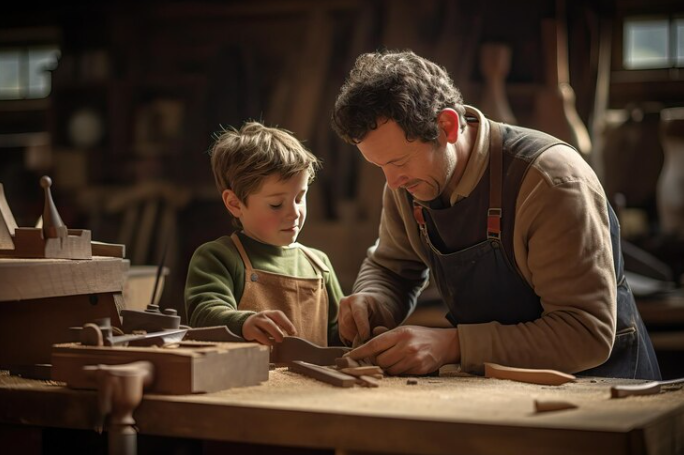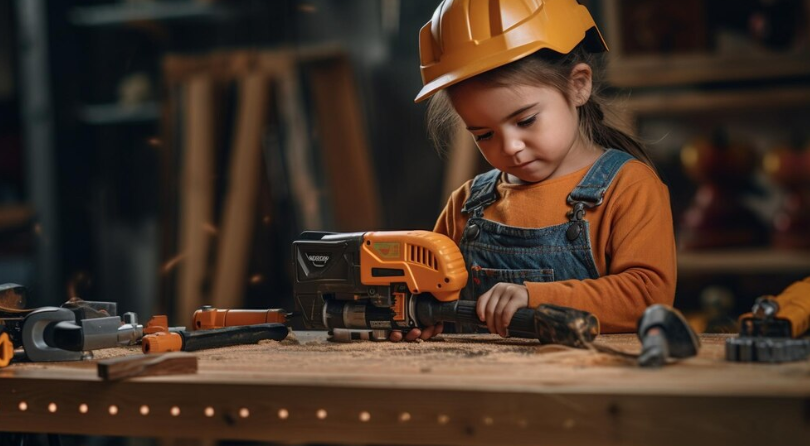Looking for a complete guide on woodworking for kids? You are in the right place, read the article till the end it will surely guide you towards enhancing your child’s creativity and will help you strengthen the bond between you and your beloved child of course.
Woodworking captivates both the young and the young at heart, offering an enchanting realm of limitless creativity and adventurous projects.
Importance of Introducing Safe and Enjoyable Woodworking to Children

Beyond crafting wooden wonders, woodworking introduces a world of skills and lifelong lessons. In a carefully supervised and nurturing environment, it becomes a tool for honing motor skills, fostering creativity, and instilling a sense of accomplishment. Safety is paramount, ensuring each experience is not only enjoyable but also a foundation for a lifetime of hands-on learning.
Fun and Age-Appropriate DIY Projects
With a commitment to fostering a love for craftsmanship from an early age, this article promises a collection of fun and age-appropriate DIY projects tailored for little crafters. From simple creations to intricate designs, each project aims to make woodworking a joyful and engaging activity for kids. The goal is to go beyond building wooden masterpieces, fostering a lifelong passion for creating and making lasting memories through the art of woodworking. Welcome to a world where sawdust and smiles harmonize in the wonders of woodworking for kids.

Setting Up a Kid-Friendly Workshop
1. Ensure a Safe and Supervised Environment
First things first, Crafting a delightful woodworking experience for kids starts with a secure and supervised workshop. Designate a space where young crafters can unleash their creativity under watchful eyes. Remove hazards, secure electrical outlets, and ensure sufficient lighting. By prioritizing safety, you create an environment for an enjoyable and worry-free woodworking adventure.
2. Choose Child-Friendly Tools and Materials
In kid-friendly woodworking, tool and material selection is crucial. Opt for tools designed for smaller hands, ensuring a comfortable grip. Choose lightweight yet sturdy materials that withstand young builders’ enthusiasm. Outfit little crafters with appropriate gear, from safety goggles to gloves, providing an extra layer of protection for confident project exploration.
3. Establish Basic Safety Rules
Set clear safety rules before the first saw is lifted. Emphasize attentive supervision, framing woodworking as a collaborative effort. Instill habits such as maintaining tidy workspaces, consistent use of safety gear, and seeking assistance when needed. Engrain these fundamental safety rules to create a secure and enjoyable woodworking space where creativity flourishes in a protected environment.
Simple and Creative Woodworking Projects for Kids
Engaging DIY Woodworking Projects for Kids
Established in a secure workshop, let’s explore simple and creative woodworking projects for little hands and big imaginations. These projects go beyond wooden creations; they’re stepping stones for young builders to bring their ideas to life—from whimsical toys to functional crafts, each designed to captivate and spark creativity.
1. Birdhouse Building:

Project Overview:
Building a birdhouse is an excellent introduction to woodworking for kids. It involves basic cutting, assembling, and painting skills.
Materials Needed:
- Wooden boards (pre-cut to simplify the process)
- Wood glue
- Nails or screws
- Sandpaper
- Non-toxic paint
Steps:
- Assemble the Pieces: Lay out the pre-cut pieces of the birdhouse and show your child how they fit together.
- Glue and Secure: Apply wood glue to the edges before joining the pieces. Assist your child in using nails or screws to secure the structure.
- Smooth Edges: Sand down any rough edges to ensure a safe and smooth finish.
- Creativity Unleashed: Let your child’s imagination run wild as they paint and decorate their birdhouse. Ensure the paint is non-toxic.
Learning Opportunities:
- Measurement and precision
- Following instructions
- Basic carpentry skills
2. DIY Wooden Bookends:

Project Overview:
Creating wooden bookends not only serves a functional purpose but also allows kids to explore shaping and decorating wood.
Materials Needed:
- Wooden blocks or pre-cut shapes
- Wood glue
- Paints or markers
- Varnish (optional)
Steps:
- Design Your Shapes: Discuss with your child what shapes they’d like for their bookends. It could be animals, letters, or any creative design.
- Assemble and Glue: Use wood glue to join the chosen wooden shapes, forming the bookends. Ensure they are stable and can support books.
- Personalize with Paint: Once the glue is dry, let your child express themselves by painting and decorating the bookends.
- Optional Varnish: For added durability, consider applying a coat of varnish. This step should be done by an adult in a well-ventilated area.
Learning Opportunities:
- Shape recognition and creativity
- Understanding structural stability
- Introduction to finishing techniques
3. Wooden Picture Frame:

Project Overview:
Crafting a wooden picture frame allows kids to showcase their favorite memories while developing woodworking skills.
Materials Needed:
- Wooden strips or pre-cut frame pieces
- Wood glue
- Small nails or brads
- Sandpaper
- Paints or markers
Steps:
- Choose Your Size: Select the size of the frame based on the picture it will hold.
- Assemble and Glue: Join the frame pieces using wood glue, forming a square or rectangle.
- Secure with Nails: Assist your child in nailing or bradding the corners for added stability.
- Smooth and Decorate: Sand down any rough edges and let your child personalize the frame with paint or markers.
Learning Opportunities:
- Measurement and proportion
- Understanding joinery
- Personal expression through decoration
4. Personalized Wooden Puzzle:

Project Overview:
Creating a personalized wooden puzzle is a unique way to combine woodworking with cognitive development. Kids will love assembling their own custom puzzle.
Materials Needed:
- Plywood or soft wood sheet
- Wood saw (adult supervision required)
- Sandpaper
- Non-toxic paint or markers
Steps:
- Design the Puzzle: Work with your child to create a simple design that can be divided into puzzle pieces.
- Cutting the Pieces: Using a saw, cut the plywood into puzzle pieces. Keep the shapes simple for easier assembly.
- Smooth the Edges: Sand down the edges of each puzzle piece to ensure they are smooth and safe for handling.
- Paint or Decorate: Let your child express their creativity by painting or decorating each puzzle piece.
- Challenge and Assemble: Once dry, challenge your child to assemble their personalized puzzle.
Learning Opportunities:
- Spatial awareness
- Fine motor skills
- Creativity and problem-solving
5. Wooden Nameplate Craft:

Project Overview:
Crafting a wooden nameplate not only introduces kids to woodworking but also allows them to personalize their space with a unique touch.
Materials Needed:
- Wooden board or plaque
- Wood saw (adult supervision required)
- Sandpaper
- Non-toxic paint or markers
- Varnish (optional)
Steps:
- Cut the Nameplate: Cut a wooden board into a rectangular shape for the nameplate using a saw (adults only).
- Smooth the Surface: Sand the surface of the nameplate to create a smooth finish.
- Personalize with Name: Let your child paint their name on the nameplate using vibrant colors or markers.
- Optional Varnish: For added protection and a polished look, apply a coat of varnish (adults only).
Learning Opportunities:
- Introduction to woodworking tools (under supervision)
- Personalization and identity
- Understanding finishing techniques
Guides for Age-Appropriate Projects
Embark on a woodworking journey with clear guides for various age-appropriate projects. Crafting a wooden puzzle, birdhouse, or personalized nameplate becomes accessible and enjoyable. Witness the magic as simple materials transform into delightful creations with these easy-to-follow steps.
1. Age 3-5: Introduction to Shapes and Colors
Projects:
- Wooden Block Painting: Provide small, pre-cut wooden blocks for your little one to paint. This helps develop fine motor skills and introduces basic shapes and colors.
- Simple Puzzle Assembly: Use large, easy-to-handle wooden puzzle pieces. This project enhances spatial awareness and problem-solving skills.
Guidelines:
- Opt for projects with minimal cutting or using pre-cut pieces.
- Ensure non-toxic paints and rounded edges for safety.
- Supervise closely during all steps, emphasizing the importance of gentle handling.
2. Age 6-8: Building Foundations
Projects:
- Birdhouse Construction: Introduce basic carpentry with pre-cut pieces for a birdhouse. This project develops assembly skills and introduces the concept of functional structures.
- DIY Wooden Bookmarks: Crafting simple wooden bookmarks allows kids to practice measuring, cutting, and decorating on a smaller scale.
Guidelines:
- Include projects with more steps for increased engagement.
- Use child-friendly tools like plastic saws under close supervision.
- Encourage independence in assembly with guidance.
3. Age 9-12: Skill Refinement
Projects:
- Wooden Picture Frame: This project involves measuring, cutting, and assembling a frame. It also introduces finishing techniques like sanding and painting.
- Personalized Wooden Puzzle: With more intricate designs, this project challenges kids’ spatial reasoning and attention to detail.
Guidelines:
- Introduce basic saws under strict supervision.
- Emphasize precision in measurements and cuts.
- Encourage creative expression through personalized design.
4. Age 13 and Above: Advanced Exploration
Projects:
- Wooden Nameplate Craft: This project involves more complex cuts and finishing. Teens can experiment with varnishing for a professional touch.
Guidelines:
- Introduce more advanced tools like hand saws and power sanders under careful supervision.
- Encourage planning and organization before starting a project.
- Discuss safety precautions and proper tool handling in detail.
Tips for Adapting Projects Based on Skill Level
In the diverse world of kids’ woodworking, one size doesn’t fit all. Recognizing varying skill levels, we offer tips to adapt projects—simplifying steps, adjusting measurements, or introducing challenges. Ensuring every child finds the perfect project, striking a balance between achievable and exciting, woodworking becomes an inclusive, customizable experience for kids of all ages and skill levels.
1. Start with Simple Designs:
When introducing woodworking to young children, opt for projects with straightforward designs. Basic shapes and structures allow them to grasp fundamental concepts without feeling overwhelmed. As their confidence grows, you can gradually increase the complexity of the projects.
Example:
- For beginners, start with projects like painting wooden blocks or assembling simple puzzles with large pieces.
2. Emphasize Safety Measures:
Prioritize safety at all times. Ensure that your child wears appropriate safety gear, including safety goggles and ear protection when using tools. Teach them the correct way to handle tools, emphasizing caution and awareness. Consider using child-friendly tools designed for their age group.
Example:
- Instruct kids on the proper use of saws and hammers, highlighting the importance of keeping fingers away from sharp edges.
3. Provide Clear Instructions:
Make sure that instructions are clear, concise, and age-appropriate. Break down the project into manageable steps, demonstrating each one before allowing your child to attempt it. Reinforce the importance of following instructions for a successful outcome.
Example:
- Use visual aids or step-by-step guides to illustrate each stage of the project, making it easier for children to understand and follow along.
4. Offer Guidance During Tool Usage:
Supervise closely during the use of tools, especially those that involve cutting or shaping wood. Provide hands-on assistance when necessary, gradually allowing your child more independence as their skills develop. Always ensure that the tools are suitable for their age and experience level.
Example:
- Guide your child’s hand as they use a saw, gradually letting them take the lead under your watchful eye.
5. Adapt Materials to Skill Level:
Choose materials that align with your child’s current skill level. For beginners, opt for softwoods that are easier to cut and shape. As their proficiency increases, you can introduce hardwoods that offer more resistance and complexity.
Example:
- Start with projects using soft pine or balsa wood before progressing to projects with harder woods like oak or maple.
6. Encourage Problem-Solving:
Woodworking provides an excellent opportunity for children to develop problem-solving skills. Encourage them to think critically about the project, identify challenges, and come up with creative solutions. This fosters independence and resilience.
Example:
- If a piece doesn’t fit as expected, encourage your child to analyze the situation and find a way to adjust or modify the design.
Educational Benefits of Woodworking for Kids

1. Cognitive and Motor Skill Development
Woodworking for kids is more than crafting—it’s a potent educational tool that nurtures cognitive and motor skills. As little hands shape visions into reality, intricate neural connections form, enhancing fine motor skills, hand-eye coordination, and spatial awareness. Beyond building wooden wonders, it lays the foundation for skills extending far beyond the workshop.
2. Enhancing Creativity and Problem-Solving
Creativity is the heartbeat of kids’ woodworking, where every project is a canvas for self-expression. Tackling challenges and making design decisions fosters critical thinking and three-dimensional problem-solving. This section explores how woodworking sparks creativity, nurtures independent thinking, and instills confidence to explore unconventional solutions, transforming raw materials into personal masterpieces on a journey of self-discovery.
3. Fostering a Love for Craftsmanship and DIY Projects
Craftsmanship is a timeless art, and introducing kids to woodworking cultivates a love for creating with their hands. Beyond joy, it instills pride and accomplishment. This section delves into the profound impact of DIY projects, where each wooden creation is a testament to skills and a source of lasting satisfaction. By fostering a love for craftsmanship early on, young woodworkers are empowered to embrace the boundless possibilities that come with the joy of creating.
Safety Measures and Supervision
- Importance of Adult Supervision: In our kids’ woodworking workshop, safety is paramount, and adult supervision is key for a secure and enjoyable experience. This section emphasizes the critical role of a watchful eye, providing security, guidance, encouragement, and essential skill impartation. Active adult presence becomes the foundation for an environment where young woodworkers can thrive with confidence.
- Teaching Tool Safety: Empowering young woodworkers extends beyond supervision; it involves educating them about tools. This section delves into the crucial task of teaching children about tool safety and proper usage. From handling tools with care to understanding their purpose, we equip little crafters with the knowledge to navigate the woodworking landscape safely, instilling a deep respect for tools.
- Balancing Safety and Enjoyment: Safety measures should enhance, not hinder, the joy of creation. In this segment, we explore strategies for seamlessly integrating safety measures into the woodworking experience. From protective gear to clear boundaries, these measures become an invisible shield, allowing kids to fully immerse themselves in the creative process. The goal is to strike a balance where safety is paramount, yet the workshop remains a space for the unbridled joy of woodworking to flourish.
Building Confidence in Young Woodworkers
- Celebrating Achievements: In the realm of young woodworkers, every cut and completed project is a cause for celebration. This section emphasizes the importance of acknowledging small victories and instilling a sense of accomplishment that fuels growing confidence. Each finished project becomes a testament to progress, effort, and creativity in their unique woodworking journey.
- Fostering Positivity: Confidence thrives in a positive and encouraging atmosphere. Here, we explore the significance of creating an environment where positivity and encouragement abound. Words of support and unwavering belief in young woodworkers’ potential shape a nurturing space where confidence can blossom. Positivity becomes an essential part of the woodworking experience, influencing how our little crafters perceive their abilities and the joy of creating.
- Embracing Perseverance and Learning: Woodworking involves challenges and learning curves. This section underscores the importance of perseverance and learning from mistakes in building confidence. By showcasing mistakes as opportunities for growth, we instill a resilient mindset. Embracing the iterative nature of woodworking empowers young builders to approach challenges with confidence, knowing that perseverance and resilience are the cornerstones of success.
Crafting Memories: Woodworking as a Family Activity
- Bonding through Woodworking: Woodworking goes beyond crafts; it’s a shared journey, a bonding experience that creates cherished memories. This section explores the profound connection formed when families come together in the workshop. Working side by side, sharing ideas, and overcoming challenges foster a unique and irreplaceable connection. Woodworking becomes a vehicle for strengthening family ties, fostering communication, and creating a tapestry of shared experiences.
- Family Participation in DIY Projects: Woodworking is best shared. This part emphasizes the importance of involving every family member in DIY projects, creating a collective sense of ownership and pride. Whether brainstorming ideas, divvying up tasks, or celebrating project completion, coming together fosters unity, reinforcing that each member contributes to the shared success of the woodworking venture.
- Creating Lasting Memories: Woodworking becomes a canvas for lasting memories. This section explores the magic of collaborative endeavors, where families transform materials into tangible expressions of shared creativity. From building a playhouse to crafting gifts, each project becomes a chapter in the family’s story—a reminder of laughter, shared efforts, and creating together. Woodworking adventures not only craft physical creations but also carve out memories that become the foundation of a shared narrative, binding families together in the heartwarming embrace of collaborative craftsmanship.
Showcasing Kid-Crafted Masterpieces

1. Spotlight on Young Woodworkers
This section turns the spotlight onto the true stars—young woodworkers and their completed masterpieces. Each creation is a testament to creativity, determination, and the joy of bringing imagination to life. From simple designs to ambitious endeavors, we celebrate the unique talents and visions that emerge when children explore the world of woodworking.
2. Gallery of Kid-Crafted Items
Prepare to be inspired with a gallery showcasing the boundless potential within each young woodworker. From whimsical creatures to imaginative crafts, this visual feast aims to spark readers’ creativity and ignite the desire to embark on their woodworking adventures with children. The gallery is a testament to the limitless possibilities when kids are empowered to transform ideas into tangible works of art.
Conclusion
As we wrap up our exploration into woodworking for kids, let’s reflect on the myriad benefits and joys this creative endeavor brings. From essential skill development to fostering creativity and craftsmanship, woodworking is a gateway where imagination shapes tangible creations. The journey has been filled with the laughter of discovery, the satisfaction of completion, and the building of lasting memories.
To parents and guardians, the woodworking workshop is an arena for shared discovery and bonding. The joys extend beyond creating wooden wonders to shared experiences, overcoming challenges together, and witnessing the growth of young woodworkers. As you embark on woodworking adventures with your children, remember it’s a canvas for creating lasting memories and strengthening family ties.
Our woodworking journey continues with your experiences and creations. Share your stories, triumphs, and projects crafted by young woodworkers. Whether a tale of a first-time builder’s excitement or a family woodworking gallery, your contributions enrich our shared narrative. The comment section becomes a virtual workshop for exchanging ideas, kindling inspiration, and celebrating the joy of woodworking as a collective community. Join us in sharing the magic and wonder of woodworking for kids, and let the creative conversations continue.

